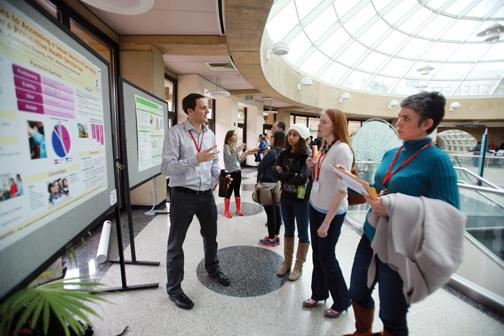Last Friday and Saturday, more than 450 San Diego State students participated in the sixth annual Student Research Symposium in Love Library.

During the event, graduate and undergraduate student researchers from an array of academic backgrounds exhibited their original research and discussed their findings with the public.
Students presented their posters during a 1-hour, 45 minute discussion period and presenters were judged by faculty and staff members from various departments. Some students also explained their research in front of well-seasoned scientific research veterans.
The students who excelled in these presentations received awards including money and a chance to compete in the annual California State University Student Research Competition.
The poster presentations showed the various research topics, with subjects ranging from the use of zinc finger proteins in gene therapy to testing steel building components during earthquakes.
A project by psychology seniors Dianna Welsh and Paul Gilbert examined how the brain separates similar memories using a process called “spatial pattern separation.” They tested behavior among young adults and plan to apply their results to in-depth psychological studies.
“We’re hoping to learn a little bit more about pattern separation—where it is in the brain, what it does, when and why it declines,” Welsh said. “Then we’ll try to find out if it has any implications for other patient populations, like those with Alzheimer’s, schizophrenia, anxiety disorders—lots of different things.”
Some students paired seemingly incompatible disciplines. Aerospace engineering junior Francisco Candido combined the structural integrity of aerospace materials with the art of origami. Candido said this interdisciplinary approach is essential for generating innovative research ideas.
“If you were just a regular student, you would never combine these two areas of study—art and engineering,” Candido said. “It’s the collaboration of different disciplines that bring new ideas to the table.”
Aside from possible monetary gain, the presentations were meant as an opportunity to gain useful experience for scientific presentations.
“SRS is great because it gives students who haven’t been to a conference before a chance to present their research and maybe practice it and refine their talk,” mechanical engineering junior Elizabeth Fortin said. “It’s cool to see everything going on around campus. All the research, all the different aspects.”
Molecular biology graduate student Adriana Trujillo emphasized the importance of participating in research symposiums.
“Going to talks and going out to big conferences are a major part of a student’s scientific career,” she said.
Four SDSU alumni, who advanced from the symposium to win the CSU Student Research Competition in May, are working on a neural chip that can relay information to prosthetic limbs.







